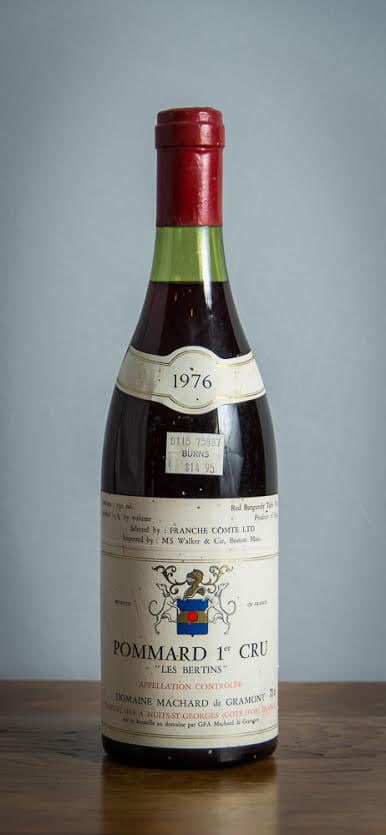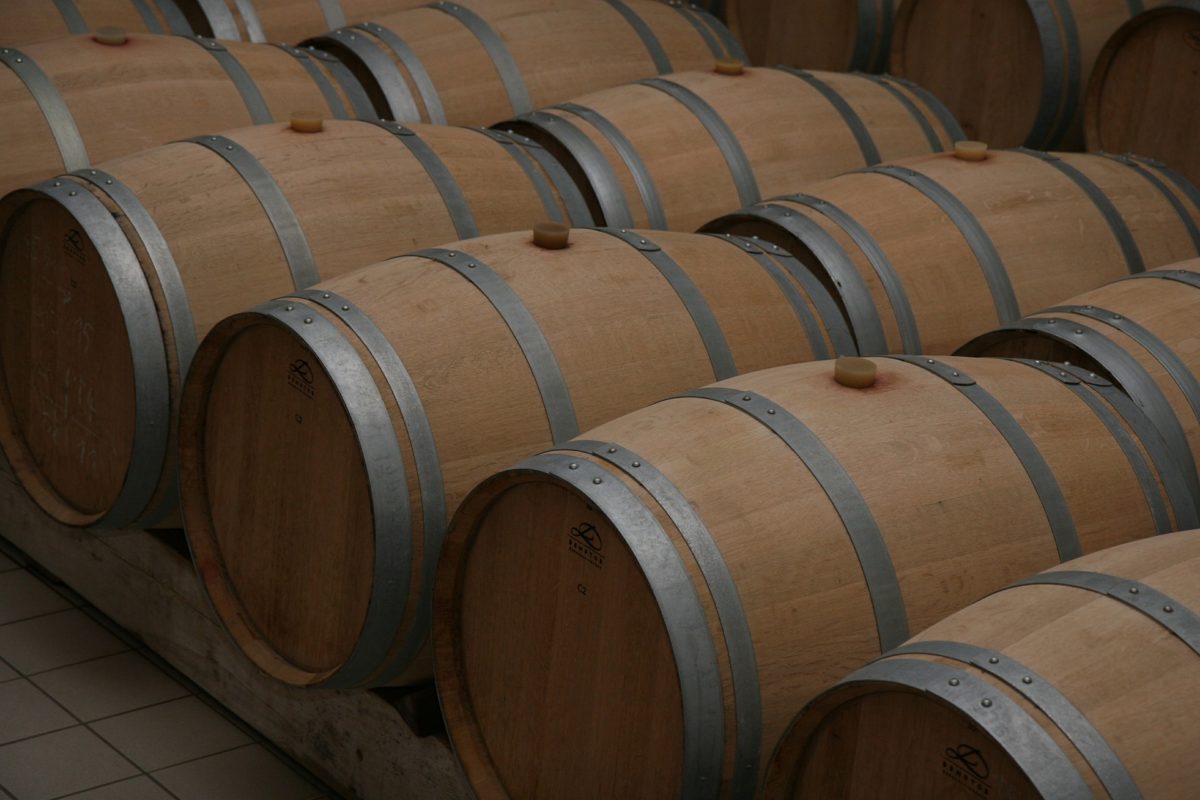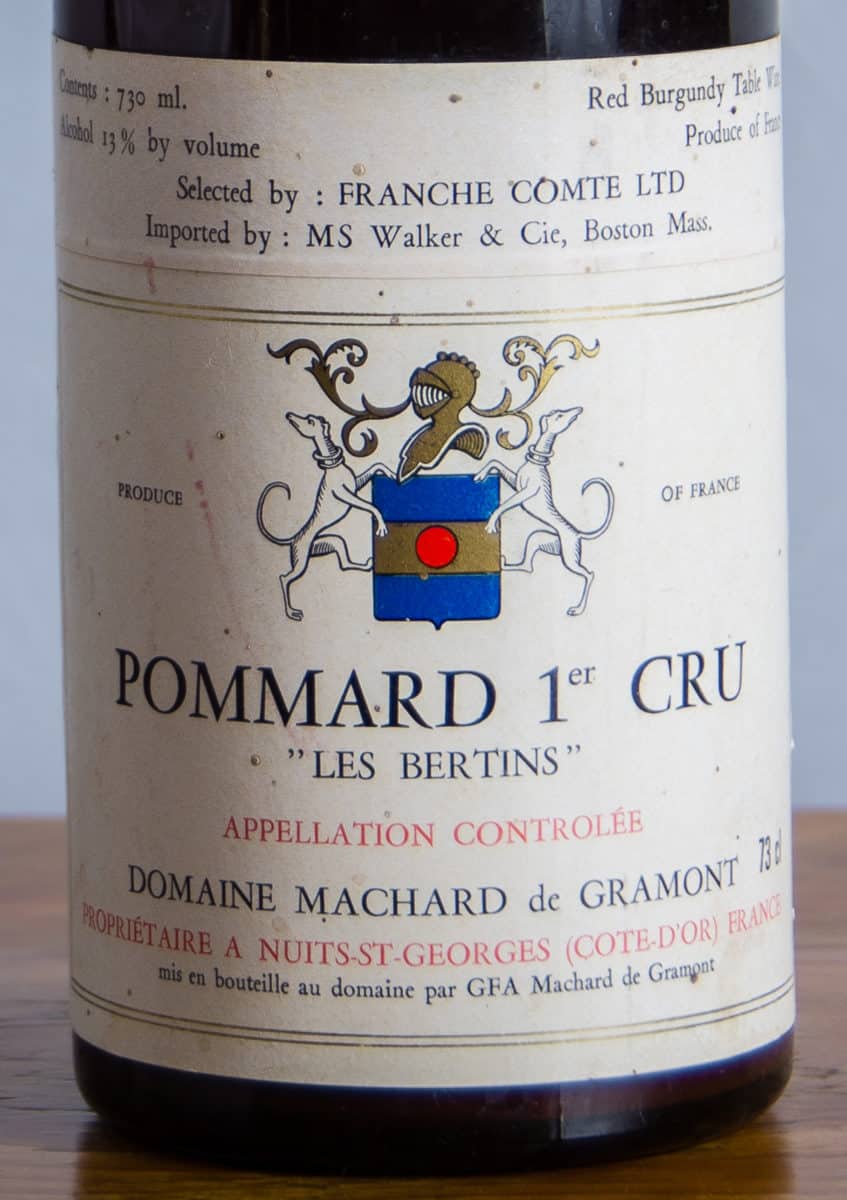A Pommard was the first true red Burgundy I ever tasted. It was, in fact, the bottle of wine that set me off, as a specific red Burgundy has done for many blessed and simultaneously cursed wine lovers, on a lifelong quest to repeat the joyous experience.
A great Burgundy is heavenly. I suspect that I entered the Burgundian world of wine via a Pommard because…I could pronounce its name. I first had it in a restaurant, where one wants to pronounce words correctly and thus not be taken for the fool one probably is. Except, as I learned later, I pronounced it incorrectly, coming down hard on the final d. As in hard.
Now I know enough to say Po-marr. And now, having recently drunk the subject of this piece – Domaine Machard de Gramont, Pommard Les Bertins, 1976 – I have regained, however briefly, that heaven I experienced with my first Pommard.
Pommard is a wine from Burgundy’s Côte de Beaune. If you want to understand (and you should) how the Côte de Beaune is distinguished from the Côte de Nuits (and how both are part of the Côte d’Or), you’ll find a serviceable explanation here. There is also much to be learned from this article by Stephen L. Baum.

Pommard was most likely named for the Roman goddess of fruit (pomom=fruit), Pomona. Though the Romans were driven out of France in around 500 A, it would be another five hundred years until Pommard was first mentioned as a wine.
Whether it was then made from Pinot Noir we don’t know – there is no mention of Pinot Noir until the late 1300s, when it was called Noirien – but it probably was.
All red Burgundy (as we know it) is made from Pinot Noir grapes. True, there is Gamay grown in Burgundy. But Gamay is used primarily in Beaujolais. Into the aforementioned late 1300s it was also used in what was called Burgundy, until it was outlawed in 1395 by Duke Philip the Bold, who called Gamay “vile and disloyal.”
The Côte de Beaune is more famous for its white Burgundies (all Chardonnay) than for its red, and correctly so. Never mind that the wonderful wine writer Harry Waugh said, “The First Duty of wine is to be red…the second is to be a Burgundy.”
"Burgundy [is] the wine that ought to be allowed to survive if it were ever decreed the only one single wine was to be left alive to do the entire work of the whole heartgladdening lot." -- Charles Edward Montague
Pommard is not one of the most distinguished wines of Burgundy. Indeed, it has not a single Grand Cru (Great Growth). But it does have twenty-seven First Growths (Premiuer Cru).
Les Bertins is one of them. It is not as famous a Pommard Permier Cru as Rugiens or Epenots, but to judge from this 1976 Domaine Machard de Gramont, it is capable of magnificence.
What makes this wine an odd bottle is not only its age, which is considerable. 1976 had a reputation first as one of the greatest vintages of the twentieth century and later as an almost complete bust.
Robert Parker comments on the vintage’s “jammy, unfocused personality and hard tannins,” and Matt Kramer writes, “Too many wines were excessively tannic, with stewed-tasting fruit and flabby acidity.”

Whatever doubts I had about this wine were dispelled upon tasting. But first there was the wine in the glass, suitably (for a Burgundy) pale when seen against light but a youngish, shining crimson when the glass was lowered and looked at from above upon a dark countertop. (In color, then, intriguingly chameleonish.)
On the nose it displayed a welcome, typical Burgundian mustiness (of the farm and the wet forest) that seems to turn to fruit before it reaches the olfactory bulb.
In the mouth, and down the throat, the wine gave the impression of astounding youth, though perhaps I am influenced in that judgment by my having known that it was nearly forty years old. It was tart, though elegant, which is typical of Les Bertins but not of Pommard in general, which is considered brawny, muscular, somewhat rustic. And it was tannic, though the tannis parted and let through blasts of fruit that made me feel reborn.
Or once again delivered to wine heaven by a Pommard.
It was served with a Boeuf Bourguignon that was as worthy of this wine as the wine was of it.
I bought this bottle for $14.95 in Springfield, Massachusetts, in the early 1980s. I don’t believe you can presently purchase any vintage of Domaine Machard de Gramont Les Bertins in the United States, but their Premier Cru Clos Blanc is generally available, for around $60, which is a relative bargain when it comes to red Burgundies. And it’s important to buy a Premier Cru – a village wine, saying merely Pommard on the label, will probably not give you the thrill you want from wine. And if a wine isn’t thrilling, then you’re putting alcohol into your body when and where you should be putting joy. ![]()
